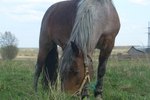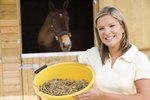Colic: The very word strikes fear into horse owners. Although it's a general term for equine gastrointestinal disease, it's also a leading cause of equine death. Colic is always a veterinary emergency. Your vet will perform certain tests to determine the severity of the condition. One common test involves inserting a nasogastric tube into your horse's stomach to determine whether he has gastric reflux.
Equine Reflux
In equines, gastric reflux means that whatever is causing the horse colic is obstructing his small intestine. Food and fluids cannot pass through the animal's digestive tract. Causes of reflux include upper gastrointestinal tract inflammation, or the intestine's inability to operate properly and propel digestion. Both of these conditions -- referred to as proximal enteritis or ileus, respectively -- can respond to medical rather than surgical treatment. However, horses with severe blockage require surgery to save their lives.
Colic Symptoms
Horses suffering from abdominal pain won't eat, and might look at their sides constantly. They might paw, roll or have a worried look. His abdomen might appear distended. If you place your ear along your horse's stomach, you might not hear gut sounds. When the vet arrives, she'll palpate your horse rectally, take his pulse, listen to gut sounds and pass a nasogastric tube into his stomach to check for reflux.
Tubing a Horse
Your vet guides the long, flexible nasogastric tube into your horse's nose, down the esophagus and into the stomach. She maneuvers it down until the tube is even with your horse's 12th rib. When the tube is in place, she checks for reflux before giving your horse medication for symptom relief.
Fluid Reflux
If fluid starts coming out of your horse's nose after intubation, that's a good thing. This fluid should flow into a bucket placed underneath the nasogastric tube. Since horses can't throw up, the accumulation of fluid in a blocked intestinal tract can result in stomach rupture. Your vet will assess the fluid reflux for color and the amount extracted. It's not uncommon for a liter or more of fluid to leave the stomach via the tube. Removing that bucket full of fluid from his stomach may well have saved the horse's life.
Reflux Contents
Your vet can determine the type of colic affecting your horse by examining the reflux contents. If the reflux is particularly bad smelling or bloody, it's likely the horse is suffering from proximal enteritis. If what comes up contains recently eaten food, your horse probably has ileus. If not treated surgically, a horse with ileus requires intubation -- resulting in decompression -- every four hours until recovery. Your vet will note the reflux volume and give your horse intravenous fluids partly based on reflux amounts.
References
- University of Florida College of Veterinary Medicine: Diseases of the Gastrointestinal Tract
- Merck Veterinary Manual: Overview of Colic in Horses
- Ohio State University College of Veterinary Medicine: Emergency Procedures in Equine Trauma and Critical Care
- Merck Veterinary Manual: Equine Emergency Procedures
- The Horse: Colic in Horses -- When is Surgery Necessary?
Photo Credits
-
Pilin_Petunyia/iStock/Getty Images
Writer Bio
Jane Meggitt has been a writer for more than 20 years. In addition to reporting for a major newspaper chain, she has been published in "Horse News," "Suburban Classic," "Hoof Beats," "Equine Journal" and other publications. She has a Bachelor of Arts in English from New York University and an Associate of Arts from the American Academy of Dramatics Arts, New York City.





